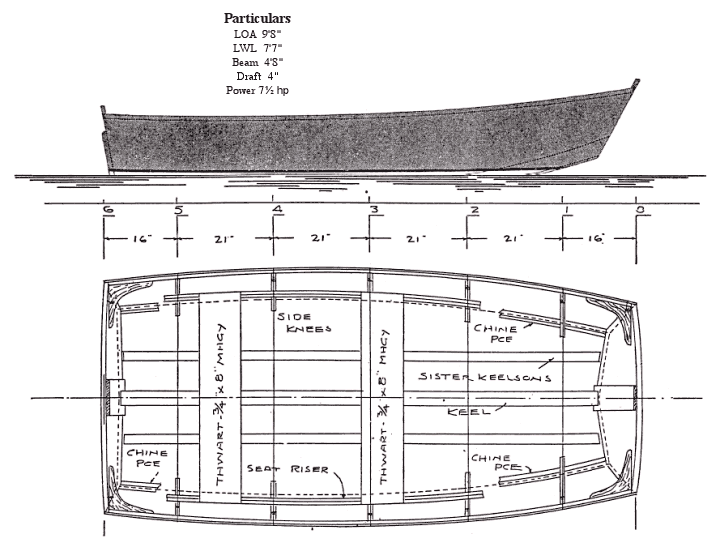

![]()

The hull lines quickly tell us that this is no ordinary pram. Unlike most of its tame cousins, which have their runs tucked up to ensure proper rowing or sailing manners and polite behavior while under tow, Chatter Box's bottom profile describes a straight line from Station No. 3 all the way aft to her rather broad transom. Designers Billy and John Atkin meant that this 9'8" pram should plane at (relatively) high speeds, while consuming moderate power.
"Speed prams," as boats of this type were called in the late 1940s and early '50s, planed easily when pushed by the 5-hp to 7 1/2-hp outboard motors common at that time. Given an unusually lightweight crew, the feisty little boxes could skitter away with as little as 3 hp clamped to their transoms (BDQ No. 26, page 10). A decade later, when manufacturers of fiberglass boats took over the industry, they showed no interest in this class. Heavy and limp 'glass could not easily (that is, inexpensively) combine low power and high performance. Eventually the speed prams were replaced by costly and short-lived inflatable boats.
Chatter Box will go together easily and, according to the Atkins, she'll make 16 mph (which will seem like 60 mph) when pushed by 7 1/2 horses. Good fun for a young skipper and Box might be an appropriate tender when we anchor the mother ship in a far corner of the harbor and want to get ashore quickly. We can explore a tidal stream that disappears under the highway bridge and runs inland for a mile, or maybe ten, and we'll be back before supper turns cold. Some fisherman might appreciate Box's ability to ride comfortably in the bed of a pickup truck, to launch easily (ramp or no), and then carry two adults and their tackle to a hidden and productive hole. This quick little pram will more than earn her modest wage.

We'll build Chatter Box over no fewer than five molds and the two transoms. That's a lot of definition for a short and simple box. Billy Atkin held strong feelings about our taking liberties with his plans, and he left little room for improvisation: "Build her exactly as drawn, Shipmates." And, yes, he insisted that we loft the plan to full scale.
We'll support Box's 1/4" plywood sheathing with skiff ("side") frames, chine logs, rails, keel, longitudinal stringers ("sister keelsons"), and two thwarts with risers. She'll go together with bronze screws and the goop of our choice. No need for epoxy here, but we can use it if we wish. The Atkins suggested that we strap a 7" x 7"x 3' flotation chamber below each thwart-appropriate insurance, though it's not shown on the drawings.
Practical little boxes of this type didn't warrant extinction. These well-detailed plans will allow us to bring them back, better than new. The designers' closing words, printed under Chatter Box's drawings in MoToR BoatinG a long time ago, seem to grant their approval to this worthwhile project: "And now we come to the end of this article and wish the best of fortune to both the builder and the product of his craftsmanship...."
![]()
Plans for Chatter Box are $100